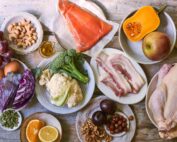Foods to Help Progesterone Levels Naturally
Do you have symptoms of low progesterone such as anxiety, irritability, impatience, insomnia, breast growth, cysts and tenderness, heavy or irregular bleeding, fluid retention and weight gain? These symptoms are common in PMS and perimenopause. Estrogen is easy to make; however, progesterone requires ovulation and is some cases the corpus luteum that is formed after ovulation doesn’t make enough to mitigate symptoms or we run out of eggs! Some food and supplements can support the ovaries and ease symptoms.
Foods can help naturally raise progesterone levels by giving the body the right nutrients that improve hormone production, the corpus luteus’s function, and the body’s own synthesis pathways. Scientific research supports dietary strategies to enhance progesterone production.
What Foods Help Increase Progesterone?
Several groups of foods are highlighted by research. In general, a Mediterranean style diet rich in fiber, omega 3 fats, a variety of vegetables rich in vitamins and minerals is best. Trans fats, refined carbohydrates, and sugar can disrupt the gut microbiome and have a negative impact on progesterone production. 1,2
- Magnesium decreases oxidative stress and preserves egg quality. 3 Foods high in magnesium: Spinach, kale, legumes, almonds, cashews, pumpkin seeds, whole grains, fish, avocados, and bananas are all good sources of magnesium.
- Vitamin C: Women who take vitamin C supplements show big increases in progesterone because it helps keep the corpus luteum healthy.4
Yellow peppers, oranges, broccoli, kiwi, and kale are some of the best sources. - Foods high in zinc: Zinc helps the pituitary gland make FSH and LH, which signals the ovaries to make estrogen and progesterone. Nuts, pumpkin seeds, sunflower seeds, and seafood all have levels that matter.
- Protein: Increased dietary protein, is linked to increased progesterone during the luteal phase. Lean meats, fish, eggs, and legumes are recommended.5
- Healthy Fats: Omega 3 fats decrease inflammation. Avocados, olive oil, fatty fish, and nuts are healthy fats.1
Cruciferous vegetables, like broccoli, kale, cabbage, and Brussels sprouts, help the liver get rid of hormones, which helps keep the progesterone-to-estrogen balance in check.
Progesterone in Food
When you eat dairy products, eggs, and beef from female animals that are of reproductive age, you get measurable amounts of progesterone.6 For overall hormonal health, whole-food diets are better because too many processed foods and trans fats lower fertility and luteal phase progesterone.
Making a Plate That Supports Progesterone
A Mediterranean-style diet that focuses on eating a lot of vegetables, fruits, olive oil, unrefined grains, nuts, and seeds is the most evidence-based way to go.
- Eat a Mediterranean diet with lots of vegetables high in fiber, lean proteins, and healthy fat from oily fish, olives, avocado, nuts and their oils.
- Avoid eating a lot of red meat, trans fats, processed food or sugar.
This type of diet enhances a healthy egg for ovulation that can produce a sufficient amount of progesterone. This can aid in the management of metabolic disorders, PCOS, endometriosis and symptoms related to low progesterone. Women who follow these kinds of diets have better progesterone levels that keep women calm, prevents excess weight, fluid retention and breast and uterine growth and promotes good sleep.
Ideas for Hormonal Health
Choosing foods that support progesterone sends a strong message of body wisdom, strength, and resilience. Every meal is an act of self-care based on science, not fads or fear. Women going through reproductive changes, stress, or hormonal changes can find a way to feel better by understanding how nutrition and endocrine health work together. Consider a complimentary diet evaluation to determine if your diet may be affecting your hormone balance. As a functional medicine doctor, I help my patients eat for hormone balance, overall health and longevity and to increase their health span.
References:
- Skoracka K, Ratajczak AE, Rychter AM, Dobrowolska A, Krela-Kaźmierczak I. Female Fertility and the Nutritional Approach: The Most Essential Aspects. Adv Nutr. 2021;12(6):2372-2386. doi:10.1093/advances/nmab068
- Andrews MA, Schliep KC, Wactawski-Wende J, et al. Dietary factors and luteal phase deficiency in healthy eumenorrheic women. Hum Reprod. 2015;30(8):1942-1951. doi:10.1093/humrep/dev133
- Kapper C, Oppelt P, Ganhör C, et al. Minerals and the Menstrual Cycle: Impacts on Ovulation and Endometrial Health. Nutrients. 2024;16(7):1008. doi:10.3390/nu16071008
- Henmi H, Endo T, Kitajima Y, Manase K, Hata H, Kudo R. Effects of ascorbic acid supplementation on serum progesterone levels in patients with a luteal phase defect. Fertility and Sterility. 2003;80(2):459-461. doi:10.1016/S0015-0282(03)00657-5
- Gorczyca AM, Sjaarda LA, Mitchell EM, et al. Changes in macronutrient, micronutrient, and food group intakes throughout the menstrual cycle in healthy, premenopausal women. Eur J Nutr. 2016;55(3):1181-1188. doi:10.1007/s00394-015-0931-0
- Colldén H, Hagberg Thulin M, Landin A, et al. Dietary Progesterone Contributes to Intratissue Levels of Progesterone in Male Mice. Endocrinology. 2023;164(8):bqad103. doi:10.1210/endocr/bqad103





She is a recognized and award-winning holistic, functional, integrative and anti-aging healthcare practitioner, speaker and author, and has been featured in ABC News, Forbes, WOR Radio and many media outlets to spread the word that you can live younger and healthier at any age.